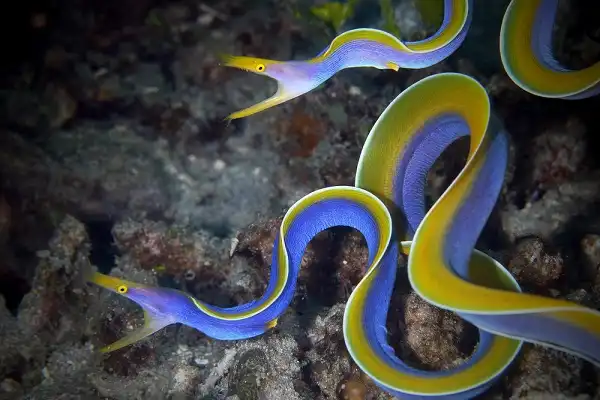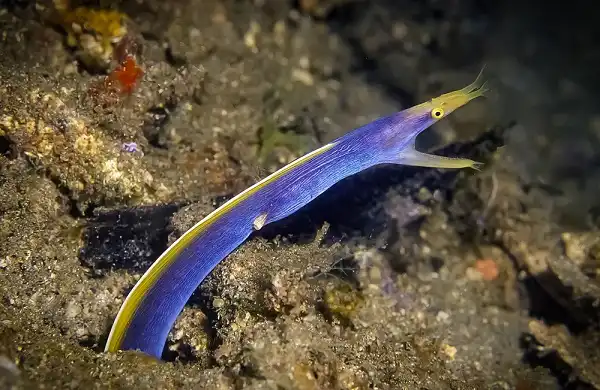Diving into a radiant underworld of aquatic treasure, the ribbon eel is one of the most captivating creatures that inhabit coral reefs. With its sleek snake-like body and unique color patterning, this elusive creature remains an enigma to many scuba divers who find themselves immersed in its mesmerizing presence. Looking for insight into this mysterious animal? We’ve got you covered! Read on for an in-depth look at why we’ve all grown so fascinated with these incredible species and how their remarkable adaptations make them a fascinating staple among reef aquarists worldwide.

Ribbon Eel Description
The ribbon eel is a species of moray eel found in tropical coral reefs across the Indo-Pacific region. It has an elongated, snake-like body. Its most prominent feature is its bright coloration, which varies from a yellowish tinge to vibrant blues and purples. In some cases, they may even display a combination of multiple colors along their length. The ribbon eel’s head is small compared to the rest of its body, with an enlarged jaw filled with sharp teeth used for hunting prey such as shrimp and small fish. Its two dorsal fins are located towards the back end of its body, and it also has two pectoral fins near its head which help it maneuver around underwater coral formations. Its eyes are exceptionally large and can almost completely cover the top of its head.
Ribbon Eel Habitat
The ribbon eel is found in tropical coral reefs located in the Indo-Pacific region. These habitats are typically characterized by warm, shallow waters teeming with corals, sponges, and anemones. Ribbon eels are usually found near areas where food sources such as shrimp and small fish are abundant. They are nocturnal creatures that spend their days hiding in crevices or burrows they dig into the sand or mud using their powerful jaws. Ribbon eels tend to live in isolated regions of the reef where oxygen levels remain relatively low due to the lack of wave action and movement of water from one area to another.
As a result, these animals rely heavily on their skin to absorb oxygen through diffusion instead of relying solely on gills like other fish species. This adaptation allows them to survive even in oxygen-depleted environments that would otherwise be inhospitable for most marine life. Ribbon eels require plenty of space and privacy when choosing a habitat, thus they often seek out areas far away from other reef dwellers. Because of this, they can often be found inhabiting caves or deep crevices within the reef structure itself – providing a safe haven away from potential predators while still allowing them access to food sources nearby.
Ribbon Eel Diet
The ribbon eel is a carnivorous species, feeding mainly on shrimp and small fish. They use their powerful jaws to catch prey and crush them before swallowing them whole. Additionally, they also have a diet of benthic invertebrates such as crabs, worms, and mollusks. Ribbon eels tend to hunt during the night time when it is quietest and visibility is reduced – allowing them to surprise prey with stealth and speed. As they are opportunistic feeders, ribbon eels will consume whatever food source is most easily available to them at any given time, although their diet tends to be composed mostly of marine organisms. In captivity, they can be fed a variety of foods such as frozen or live shrimp, live worms and fish, and certain types of pellets specifically designed for moray eels. It is important for owners to ensure that the aquarium environment provides an adequate amount of food sources in order for the ribbon eel to remain healthy and well-nourished.

Ribbon Eel Size
Ribbon eels can range in length from 2 to over 4 feet, with an average size of around 3 feet. They have a slender body shape that is tapered at both ends and is typically highly colorful with a mottled pattern of blues, yellows, greens, and purples along their back. Ribbon eels are often mistaken for the similarly colored but unrelated moray eel species due to their lack of external scales.
Ribbon Eel Lifespan
The ribbon eel is believed to have an average lifespan of around 7-10 years, with some individuals living up to 15 years in captivity. While the exact life cycle of a ribbon eel is still largely unknown, it is thought that they may spawn in the ocean depths and then migrate to shallow waters as juveniles. Additionally, they may also exhibit a form of sexual dimorphism, with males possessing a blue coloration while females are typically green or yellow. Overall, the ribbon eel is an incredibly fascinating species that captivates us with its vibrant colors and mysterious behaviors – providing us with hours of entertainment each day! With proper care and nutrition, ribbon eels can live quite long lives in optimum conditions – providing owners with many years of enjoyment!
Ribbon Eel Behavior
Ribbon eels generally exhibit solitary behavior, inhabiting their own small territory or living in small groups. They are nocturnal predators, emerging from their hiding spots at night in order to hunt for prey. Some of their hunting strategies include jaw scraping, which allows them access to tight crevices and burrows where small prey might be hiding. Ribbon eels also possess unique abilities such as the ability to gulp air from the surface and absorb oxygen through their skin, allowing them to inhabit areas with low or nonexistent oxygen levels due to the lack of wave action or water movement. Overall, ribbon eels are fascinating underwater creatures that captivate us with their stunning colors and mysterious behaviors – providing us with hours of entertainment each day! With proper care and nutrition, these amazing animals can live quite long lives even in harsh underwater conditions – making them great companions for any fish enthusiast!

Ribbon Eel Speed
Ribbon eels are relatively fast swimmers, able to reach speeds of up to 6 mph (9.6 km/h). This impressive speed is most likely due to their slender, hydrodynamic bodies which reduce drag and allow them to move quickly through the water. Additionally, ribbon eels also possess an extra set of pectoral fins located near their gills that help them to maneuver quickly in tight spaces. The ribbon eel’s ability to swim at such high speeds helps them immensely when it comes time for hunting or escaping predators. They use their incredible speed and agility to chase down small fish and crustaceans or evade any potential threats before they become a meal themselves. It has been observed that ribbon eels can even outswim some larger predatory fish in certain situations – making it an essential tool for survival in their underwater habitat!
Ribbon Eel Hunting
Ribbon eels are skilled hunters, using their swiftness and agility to chase down small prey such as fish and crustaceans. They rely on their unique ability to gulp air from the surface which allows them to absorb oxygen through their skin – allowing them to remain energized for longer periods of time. Their slender bodies also help them move quickly and with greater control in tight spaces, making it easier for them to pursue their target or evade predators.
When hunting, ribbon eels display a variety of strategies including jaw scraping which allows them access to crevices and burrows that might otherwise be inaccessible. They may also use ambush tactics by lying in wait amongst coral reefs or other structures until unsuspecting prey swims close enough for the ribbon eel to strike!
Ribbon Eel Reproduction
Ribbon eels have an interesting mode of reproduction. They are sequential hermaphrodites, meaning they start life as males and can later change into females as they reach adulthood. The process usually begins during the late juvenile stage, when the male’s anal fin begins to enlarge and transform into a reproductive organ. This organ is then used to release gametes (eggs or sperm) into the water column for fertilization. Once a ribbon eel has changed sex, it will remain female for the duration of its life. During the spawning season, ribbon eels aggregate in large groups known as spawning aggregations, where each female will release thousands of eggs simultaneously to increase the chances of fertilization by several different males. The eggs are buoyant and float to the surface where fertilization occurs in the water column before sinking back down again.

Conclusion
Ribbon eels are an amazing species of fish that can bring hours of enjoyment to owners and observers alike. Not only are they incredibly beautiful creatures, but they also possess remarkable hunting abilities and fascinating modes of reproduction. With proper care and nutrition, ribbon eels can live for many years in aquariums – providing aquarium hobbyists with years of entertainment! So if you’re looking for a unique and hardy fish that will add some exciting activity to your tank, the ribbon eel is definitely worth considering!
Frequently Asked Question

